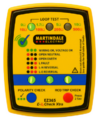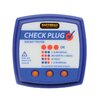I'm expanding a solar power system on an outbuilding, and part of that was to get a bigger inverter.
Wired it up as recommended including earth lug to service earth.
However when doing a check before using and fitting the extra panels, my Martindale socket tester came up with an earth fault notification.
When plugging in the socket tester to the same service circuit it came up fine.
Thought I'd then put the old inverter back in and revert to the old setup and it came up with the same earth fault reading.
I then tested each solar panel individually (I am adding two to the existing one), and each came up with the same fault.
In addition I am adding a second battery, so tested on both and got the same thing.
Reading up on the inverter manual it says that the earth lug is connected to the neutral internally.
So is this why the socket tester thinks it's an earth fault?
I also found online that an earth fault can be caused by water getting into a solar panel.
I can understand if that were the case with the original one, but both new ones?
Any advice would be appreciated.
Wired it up as recommended including earth lug to service earth.
However when doing a check before using and fitting the extra panels, my Martindale socket tester came up with an earth fault notification.
When plugging in the socket tester to the same service circuit it came up fine.
Thought I'd then put the old inverter back in and revert to the old setup and it came up with the same earth fault reading.
I then tested each solar panel individually (I am adding two to the existing one), and each came up with the same fault.
In addition I am adding a second battery, so tested on both and got the same thing.
Reading up on the inverter manual it says that the earth lug is connected to the neutral internally.
So is this why the socket tester thinks it's an earth fault?
I also found online that an earth fault can be caused by water getting into a solar panel.
I can understand if that were the case with the original one, but both new ones?
Any advice would be appreciated.





